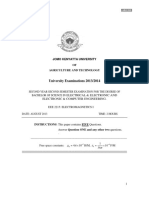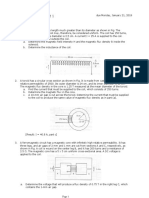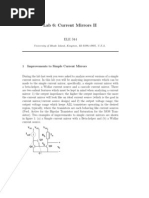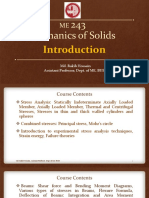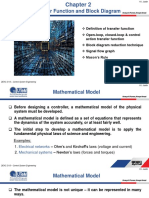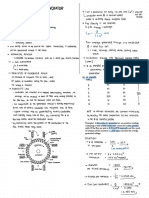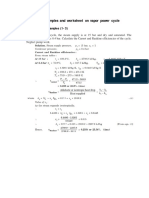Tutorial 3
Uploaded by
slim_nitemareTutorial 3
Uploaded by
slim_nitemareTutorial # 3
1. A ferromagnetic ring with a mean circumference of 36 cm and a cross-sectional area of 3 cm2 is wound with 400 turns of wire. When the excitation current is 1.4 A, the flux is found to be 1.4 mWb. Determine the relative permeability of the iron.
(The solution is 2387)
2. A cast steel ring has a mean length of 30 cm and an air gap of 2 mm length. Find the number of ampere-turns required to produce a flux of 0.6 T in the air gap.
(The solution is 1084 At)
3. Find the average value of permeability (B/H) of sheet steel for the flux densities of B1 = 0.4T, B2 = 0.8 T, B3 = 1.2 T, and B4 = l.6 T.
(The solution is 3.08x10-3 H/m; 2.16x10-3 H/m; 1.67x10-3 H/m; 0.604x10-3 H/m)
4. A cast iron pipe has a 100-turn coil wound on it, as illustrated in Figure 1. The dimensions (in cm) are as indicated; (a) (b) For a coil current of 10 A, determine the flux set up in the material. If a cast steel pipe had been used, what coil current would he required to establish the same flux as part in (a)?
Figure 1
(The solution is (a) 432 Wb; (b) 1.1 A)
5. Calculate the magnetization curve for: (a) The circuit shown in Figure 2 and, (b) The same circuit with an air gap introduced as indicated by the dotted lines. The excitation coil has 200 turns, and the material is sheet steel. Plot the total flux as a function of excitation current for flux values of 4 to 12 mWb, in steps of 2 mWb. The dimensions (in cm) are as indicated;
18
0.1
10
10 10
18
Figure 2
(The solution is (a) 4 mWb, 0.65 A; 6 mWb, 1.12 A; 8 mWb, 1.26 A; 10 mWb, 2.70 A; 12 mWb, 6.00 A; (b) 4 mWb, 2.64 A; 6 mWb, 4.10 A; 8 mWb, 5.73 A; 10 mWb, 7.68 A; 12 mWb, 11.95 A)
6. A 280-turn coil is wound on the center leg of the sheet steel core shown in Figure 3. A flux of 1 mWb is required in the air gap. The core is built up to a thickness of 3 cm. Determine the coil current. The dimensions (in cm) are as indicated;
Figure 3
(The solution is 2.74 A)
You might also like
- Exam EEE 2215 Electromagnetics I - 2013-2014 Latest August 2013-1No ratings yetExam EEE 2215 Electromagnetics I - 2013-2014 Latest August 2013-116 pages
- Chapter One: Electromagnetic PrinciplesNo ratings yetChapter One: Electromagnetic Principles43 pages
- Optimization and Development of Pulverization MachineNo ratings yetOptimization and Development of Pulverization Machine7 pages
- University of Rizal System: Electro-Mechanical Energy Conversion (EE 4) (For Completion)No ratings yetUniversity of Rizal System: Electro-Mechanical Energy Conversion (EE 4) (For Completion)9 pages
- 243 Mechanics of Solids: Md. Rakib Hossain Assistant Professor, Dept. of ME, BUETNo ratings yet243 Mechanics of Solids: Md. Rakib Hossain Assistant Professor, Dept. of ME, BUET23 pages
- 30 TOP MOST MAGNETIC CIRCUIT - Electrical Engineering Multiple Choice Questions and Answers Electrical Engineering Multiple Choice Questions100% (1)30 TOP MOST MAGNETIC CIRCUIT - Electrical Engineering Multiple Choice Questions and Answers Electrical Engineering Multiple Choice Questions10 pages
- Lab Assignment #06: Electric Circuit Analysis I EEE-121100% (1)Lab Assignment #06: Electric Circuit Analysis I EEE-1216 pages
- 50 TOP MOST Electromagnetic Induction - Electrical Engineering Multiple Choice Questions and AnswersNo ratings yet50 TOP MOST Electromagnetic Induction - Electrical Engineering Multiple Choice Questions and Answers9 pages
- Lab Activity 4: Verification of Superposition Theorem: ObjectivesNo ratings yetLab Activity 4: Verification of Superposition Theorem: Objectives4 pages
- 7 Magnetic Circuits: B, and State Their Units A H L ANo ratings yet7 Magnetic Circuits: B, and State Their Units A H L A10 pages
- T.284xlobmaxwell-Slots - In: Direct GeneratorNo ratings yetT.284xlobmaxwell-Slots - In: Direct Generator7 pages
- P.P.10.1 Node Analysis of Phasor CircuitsNo ratings yetP.P.10.1 Node Analysis of Phasor Circuits10 pages
- 07 03 06 08 8.the Steady Magnetic FieldNo ratings yet07 03 06 08 8.the Steady Magnetic Field42 pages
- DC Circuits:: DET 101/3 Basic Electrical Circuit 1No ratings yetDC Circuits:: DET 101/3 Basic Electrical Circuit 1150 pages
- Thermo-2 Worked Examples and Worksheet On Vapor Power CycleNo ratings yetThermo-2 Worked Examples and Worksheet On Vapor Power Cycle11 pages
- UEME3112 Fluid Mechanics II May 2019 CFD Assignment: Laminar Pipe FlowNo ratings yetUEME3112 Fluid Mechanics II May 2019 CFD Assignment: Laminar Pipe Flow18 pages
- Resistivity Modeling: Propagation, Laterolog and Micro-Pad AnalysisFrom EverandResistivity Modeling: Propagation, Laterolog and Micro-Pad AnalysisNo ratings yet
- Due Date: University of Waterloo Electrical & Computer Engineering DepartmentNo ratings yetDue Date: University of Waterloo Electrical & Computer Engineering Department14 pages
- Engineering Workplace Skills: Developing Reasoned ConclusionsNo ratings yetEngineering Workplace Skills: Developing Reasoned Conclusions17 pages

